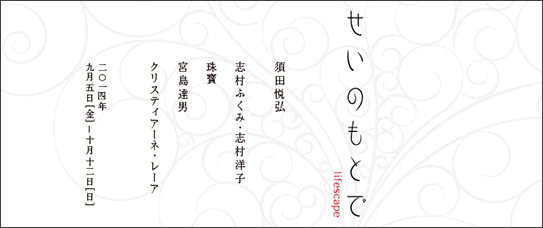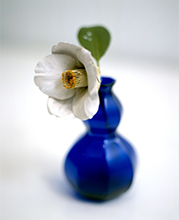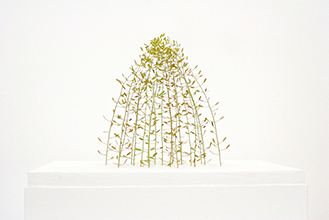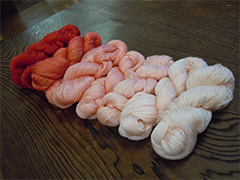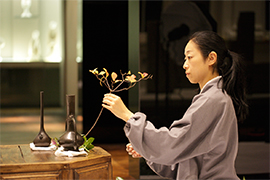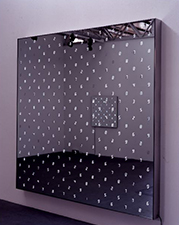Sei no Motode - lifescape
September 5th (fri) - October 12th (sun), 2014
Shiseido was founded in 1872 as Japan's first Western-style pharmacy. The name of the company came from a phrase, “banbutsu shisei,” in the “Yi Jing”(the Chinese Book of Changes), which describes “all things emerging through the creative blessing of the great Earth.” Many important Shiseido design elements (the camellia blossom in the company trademark*1, for example, and the use of rich arabesque motifs*2) represent concrete visualizations of this creative spirit, icons expressive of the vitality of growing plants that shoot forth new life in cycle with the changing seasons.
The Shiseido-hosted exhibition Sei no Motode — lifescape is an attempt to express the creative worldview of banbutsu shisei. While it is not uncommon for art exhibitions (including many at the Shiseido Gallery) to focus on specific themes, this exhibition was conceived with the idea of working with a theme reflective specifically of Shiseido's own corporate ideals. Sei no motode — lifescape will be curated by Suda Yoshihiro, a contemporary artist known for his delicate, extraordinarily lifelike woodcarvings of flowers and other plants. Other participating artists will include sculptor Christiane Löhr, textile artisans Shimura Fukumi and her daughter Shimura Yōko, ikebana (flower arrangement) master Shuhō, and contemporary artist Miyajima Tatsuo. Each of these has been selected for his or her artistic capacity to express the nobility and sacredness of life through superlative sensitivity and technique.
Artist Christiane Löhr, who lives in Germany and Italy, uses dried plants as her main medium to create her sculptural works. In such pieces she attempts to understand rules of life by observing the behavior and emergence of plants. While most of her works are quite small, they seem to crystalize the life force within plants, and still emanate a sense of almost divine presence.
Japanese “living national treasure” Shimura Fukumi and her daughter Yōko are textile artisans who work in traditional vegetable-dyeing and weaving techniques. For this exhibition they will present not their usual beautifully dyed kimono fabrics, but rather the beauty of the fibers themselves, each thread “colored in the life of plants.” This dynamic installation was suggested by curator Suda, and it will be the first time for the Shimuras to present their work in such a format.
Shuhō is the ikebana master at Kyoto's Ginkakuji (Jishōji) Temple. For this exhibition she presents a video record of her work creating floral arrangements within that famous landmark temple. The dignified shapes of her arrangements are clearly a manifestation of her earnest attempt to “listen to the voices of the flowers.” Shuhō's video will also include scenes of Tōgūdō Hall, a structure considered to be a Japanese national architectural treasure.
While the aforementioned artists all take flowers and plants as their materials or motifs, Miyajima Tatsuo is completely different, internationally known for works composed of LED-based digital counters. Of these he says, “Keep going.Connect with all.Gose on forever” Though this consistent production concept, Miyajima's work expresses the preciousness of life continually recreated and reborn, and the same is true of this new installation for this exhibition, which he has designed to match the gallery's unique space.
Curator Suda has also selected an assortment of Shiseido product packages, advertisements, and other artifacts that represent important elements of the company's design efforts (camellia blossoms, arabesques, etc.), and these will be displayed interspersed among the other art works. And course, a few of Suda's own sculptures will also be found, somewhere, in the galleries.
With Sei no Motode — lifescape, the Shiseido Gallery offers a gathering of diverse personalities and distinctive worldviews to explore the world of banbutsu shisei from numerous perspectives. With Suda taking his first curatorial role and the Shimuras presenting their first installation-style work, this exhibition breaks new ground on several fronts, and we welcome all to come have a look!
| *1 |  |
*2 | 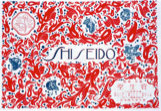 |
| Shiseido's camellia blossom logo | Shiseido arabesque motif on wrapping paper |
